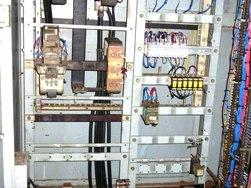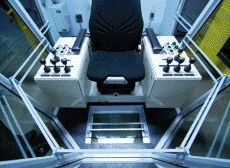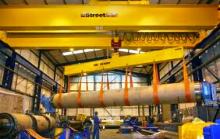Control systems for electric drives of cranes
 Various crane control systems can be classified according to purpose, control method and regulation conditions.
Various crane control systems can be classified according to purpose, control method and regulation conditions.
According to their purpose, the control systems of lifting mechanisms, movement mechanisms and rotation mechanisms are distinguished.
According to the management method, there are management systems with feed chamber controllers, with button posts, with complete devices (eg with or without magnetic controller and energy converter).
According to the regulation conditions, there may be control systems: with regulation of speed below nominal, with regulation of speed above and below nominal, with regulation of acceleration and deceleration.
Four types of electric motors are used in crane drive systems:
-
DC motors with series or independent excitation with regulation of speed, acceleration and deceleration by changing the voltage and excitation current supplied to the armature,
-
asynchronous rotor motors by adjusting the above parameters by changing the voltage applied to the stator winding of the electric motor, the resistance of the resistors in the rotor winding circuit and using other methods,
-
asynchronous squirrel-cage motors with constant (at nominal grid frequency) or adjustable (at inverter output frequency adjustment) speed,
-
squirrel-cage rotor induction motors, multi-speed (pole-switched).
Recently, the number of AC faucets is increasing due to the improvement of systems variable frequency drive.

For DC motors of lifting mechanisms, controllers with an asymmetric circuit and potentiometric activation of the armature in the lowering positions are used, for travel mechanisms - controllers with a symmetrical circuit and resistors connected in series.
For asynchronous electric motors with a squirrel-cage rotor, controllers are used that perform only the functions of turning on and off the electric motor; for phase-wound rotor induction motors, controllers switch the stator windings and resistor stages in the rotor winding circuit.
The main disadvantages of electric drive systems with cam controllers: low energy indicators, low level of wear resistance of the contact system, insufficient smoothness of speed regulation.
The use of self-excited electrodynamic braking for these lifting mechanism systems (when lowering the load) improves the energy and control properties of the systems, in particular, a speed regulation range of up to 8:1 (when lowering the load) can be achieved.
Control systems with power regulators are generally used for low-speed cranes operating with low requirements for speed control range and braking accuracy. In the conditions of metallurgical workshops, these are general-purpose bridge cranes.
Control systems with magnetic controllers is used for crane electrical equipment operating on direct and alternating current with relatively high power (for direct current up to 180 kW). In alternating current, these systems are used to control single- and two-speed asynchronous electric motors with a rotor squirrel-cage and wound-rotor asynchronous electric motors.
These magnetic controller systems for controlling asynchronous squirrel-cage motors are typically used on cranes with motor power up to 40 kW, and for wound-rotor asynchronous motors in the power range 11-200 kW (for lifting mechanisms) and 3.5-100 kW (for motion mechanisms).

The use of these control systems is effective for crane mechanisms where it is necessary to meet the strict requirements in terms of speed control, for example for gantry cranes, bridge cranes with manipulators.
Control system for crane electric drives DC G-D (generator-motor) was widely used in electric crane drives until the 1960s and 1970s because of the following main advantages: a significant speed control range (20:1 or more ), smooth and economical speed and braking control, long service life, relatively low cost.

Control systems with thyristor voltage converters and DC motors (TP — DP) allow use thyristor deviceby changing the opening angle of the thyristors, adjust the voltage supplied to the electric motor.
TP — DP systems are used for electric drives with power up to 300 kW, and in some cases even more.They have high control properties and with a control range of 10:1 — 15:1, they do not require the use of tachogenerators for speed control. By using tachometric speed feedback in these systems, a speed control range of up to 30:1 can be obtained.
The disadvantages of the TP — DP systems are: the relative complexity of the thyristor blocks of the device, relatively high capital and operating costs, deterioration of the quality of electricity in the network (impact on the network).
Control systems with frequency converters (FC — AD) allow in crane electric drives, when squirrel-rotor asynchronous electric motors are used, to obtain a high speed control range with good dynamic characteristics of the electric drive.
